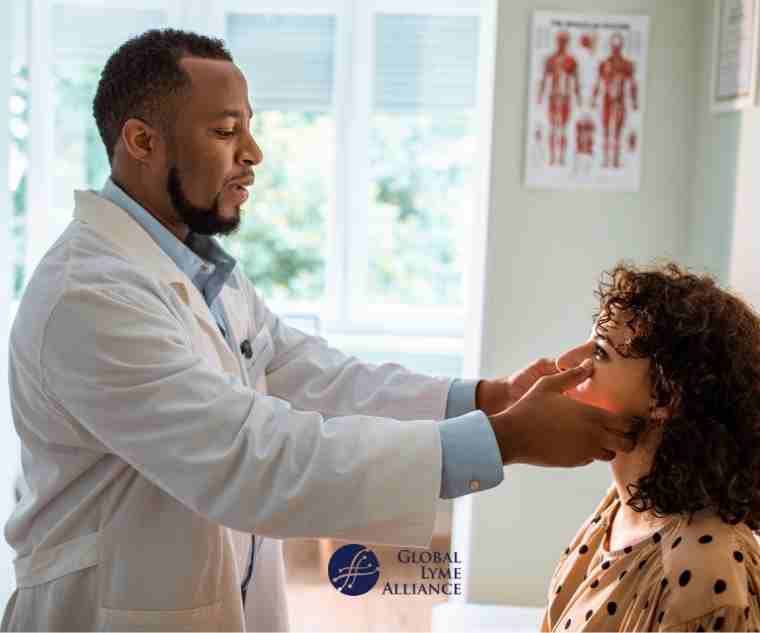
Neurological disorder resulting from COVID-19 may confound Lyme disease diagnosis.
Bell’s palsy is a non-progressive neurological disorder of one of the facial nerves (7th cranial nerve). Bell’s palsy is fundamentally a clinical diagnosis with no specific laboratory test to confirm the disorder.1 This disorder is characterized by the sudden onset of facial paralysis that may be preceded by a slight fever, pain behind the ear on the affected side, a stiff neck, and weakness and/or stiffness on one side of the face. Paralysis results from decreased blood supply and/or compression of the 7th cranial nerve. This compression can be caused by inflammation of the tissue around the nerve. Approximately 40,000 individuals are diagnosed with Bell’s palsy in the US each year, affecting males and females in equal numbers.
The exact cause of Bell’s palsy is not known, however, bacterial infections (like Lyme disease),1 and viral infections (like Herpes and Epstein-bar virus),2 immune disorders (like Guillain-Barre syndrome) and neuropathies (like brain tumors), are frequently implicated as a cause.
Neurological Lyme Disease and Bell’s Palsy
Bell’s palsy is the most common manifestation of Lyme neuroborreliosis (or neurological Lyme disease) in the US.1 Clues pointing toward Lyme neuroborreliosis include a history of rash compatible with a bull’s-eye erythema migrans (EM) rash or fever in the weeks preceding the palsy. Treatment with antibiotic therapy is highly effective, and most patients will fully recover facial nerve function.1 According to Dr. Nate Jowett, M.D. (Massachusetts General Brigham) ~5% of patients with Lyme disease will develop some degree of sudden facial weakness, where one or both sides of the face droop. This tends to occur seven- to 21-days after tick exposure in infected patients.
COVID-19 and Bell’s Palsy
More recently, though a rare occurrence, Bell’s palsy has also been associated with COVID-193 and adverse drug reactions following mRNA-based vaccination for COVID-19.4-7 A recent systematic review found 20 COVID-19 patients whose only major neurological manifestation was Bell’s palsy. In a separate report, according to Colella et al.,an otherwise healthy 37-year-old white Caucasian male developed Bell’s palsy within days after COVID-19 vaccination. Of note, there was no history of trauma, cold or other identifiable triggers reported and no other signs or symptoms were present. Specifically, no history of a preceding infection, including recent SARS-CoV-2 infection, was reported and there was no evidence of a cutaneous rash suggestive of Herpes zoster infection.6 Lack of a cutaneous rash (e.g., EM) might also rule out Lyme disease, though it should be noted that EM may be missed or not develop in some Lyme disease cases.8
Bell’s palsy associated with SARS-CoV-2 infection was either the first neurological manifestation or appeared two to 28 days after the appearance of other clinical manifestations.3 When associated with COVID-19 vaccination Bell’s palsy developed between three and 30 days post second-dose vaccination.6 The FDA points out that cases of Bell’s palsy in vaccine groups did not represent a frequency above that expected in the general population and concluded that currently available information was insufficient to determine a causal relationship with the vaccine. Nevertheless, they also recommend surveillance for cases of Bell’s palsy with deployment of the vaccine into larger populations.6
Since the time frames for onset of Bell’s palsy associated with Lyme disease and SARS-CoV-2 infection or COVID-19 vaccination overlaps, it is important for front-line physicians to be aware that when faced with differentially diagnosing a patient that presents with Bell’s palsy they should consider:
- The prevalence of ticks and Lyme disease in the geographic area in which the patient resides
- Case history of the individual that may increase the risk of coming into contact with ticks and contracting Lyme disease (time of year, outdoor activities, pets, ), finding a tick on themselves, and/or travel to a Lyme-endemic area to name a few
- Other symptoms consistent with Lyme disease (g., EM, arthritis, carditis, other neurological complications, etc.)
- Timing of the onset of Bell’s palsy and when they contracted COVID-19 or underwent vaccination for COVID-19
In conclusion, the COVID-19 pandemic, in addition to causing a whole new set of public health challenges associated with SARS-CoV-2 infections, has also further confounded physicians’ efforts to distinguish Lyme neuroborreliosis from other disorders that cause neurological disease. It is recognition of these complexities that leads GLA to invest financial resources and support research that will ensure rapid and accurate diagnosis and effective treatment of Lyme neuroborreliosis.
REFERENCES
1 Marques, A., Okpali, G., Liepshutz, K. & Ortega-Villa, A. M. Characteristics and outcome of facial nerve palsy from Lyme neuroborreliosis in the United States. Ann Clin Transl Neurol 9, 41-49, doi:10.1002/acn3.51488 (2022).
2 Zhang, W. et al. The etiology of Bell's palsy: a review. J Neurol 267, 1896-1905, doi:10.1007/s00415-019-09282-4 (2020).
3 Gupta, S., Jawanda, M. K., Taneja, N. & Taneja, T. A systematic review of Bell's Palsy as the only major neurological manifestation in COVID-19 patients. J Clin Neurosci 90, 284-292, doi:10.1016/j.jocn.2021.06.016 (2021).
4 Cirillo, N. & Doan, R. The association between COVID-19 vaccination and Bell's palsy. Lancet Infect Dis 22, 5-6, doi:10.1016/S1473-3099(21)00467-9 (2022).
5 Cirillo, N. & Doan, R. Bell's palsy and SARS-CoV-2 vaccines-an unfolding story. Lancet Infect Dis 21, 1210-1211, doi:10.1016/S1473-3099(21)00273-5 (2021).
6 Colella, G., Orlandi, M. & Cirillo, N. Bell's palsy following COVID-19 vaccination. J Neurol 268, 3589-3591, doi:10.1007/s00415-021-10462-4 (2021).
7 Cirillo, N. Reported orofacial adverse effects of COVID-19 vaccines: The knowns and the unknowns. J Oral Pathol Med 50, 424-427, doi:10.1111/jop.13165 (2021).
8 Schutzer, S. E. et al. Atypical erythema migrans in patients with PCR-positive Lyme disease. Emerg Infect Dis19, 815-817, doi:10.3201/eid1905.120796 (2013).

Timothy Sellati, P.h.D.
Former Chief Scientific Officer at Global Lyme Alliance
Timothy J. Sellati, PH.D. is Former Chief Scientific Officer at Global Lyme Alliance. As GLA’s Chief Scientific Officer, Dr. Sellati led GLA’s research initiatives to accelerate the development of more effective methods of diagnosis and treatment of Lyme and other tick-borne diseases.
